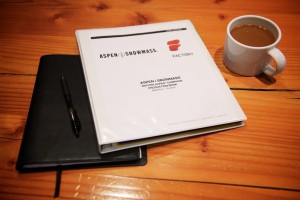
One golden rule to a great photoshoot is to start with great production. A smooth production puts everyone and everything in the right place for the shoot to succeed long before the shutter button gets pressed. That said, I have some of the best producers in the biz on staff. And here, Megan outlines one essential to every commercial production – the production notebook. Use this info to help make your next production run smooth like butta’… Take it away, Meg.
___
Hello peeps, Megan here, producer for Chase. We’re gearing up for a several big international jobs, so as I’m booking travel and working with a local producer on locations + permits, I’m also putting the Production Book together. This is critical information that all professional production houses put together and it’s something clients and agencies expect from you on any large-scale shoot. Think of it as a one-stop shop for all pertinent details. It can be distributed to all parties via email prior to the shoot, and a printed copy should accompany you to set. Not only does it help make you look super professional, it just might be the most practical thing you carry (aside from your camera, of course).
You don’t need special software; start with a Word or Pages doc. Just keep an eye on formatting. It should be clean, easy to read and align with your brand. Once it’s complete, save a template you can always use to generate this doc for your next shoot, then output a PDF for the production crew and send it out!
When it comes to printing and binding your Production Book, it’s important to ensure it looks polished and professional. You’ll want to print on high-quality paper that gives the book a sturdy, executive feel. Consider a simple, clean binding method like a coil or perfect binding, which will make it easy to flip through while maintaining a sleek presentation.
Utilizing Online Printing Services such as DocuCopies.com can streamline the process, offering affordable options for high-quality print jobs. This service can help you print multiple copies of the Production Book, perfect for handing out to your crew, clients, or other stakeholders.
From selecting the right binding style to choosing the paper weight and finish, these services make it simple to get your Production Book ready in no time. Once printed, you’ll be able to distribute the book both physically and digitally, ensuring everyone is on the same page when it’s time to hit the set.
Here’s a basic list of things to include (as applicable):
1. cover sheet: a nicely laid out page that identifies the client, the production company and/or the photographer
_client + photographer logos
_name of job
2. contact info: detail the names, titles, phone numbers + email address of all associated parties
_client
_agency
_crew
3. shot list / creative: detailed shot list and/or photo references
_wardrobe/prop specs
_art direction
4. travel itineraries: who’s going where and when?
_flights
_confirmation numbers
5. accommodations: where is everyone staying?
_address
_contact
_check in/out dates
_directions to/from airport
_meeting room location + details
6. location info: every shoot happens somewhere, whether it’s at your studio or the Mojave desert
_address
_contact info (i.e. site rep)
_map
_directions
_photos
_certificates of insurance for each
_releases
_permit info
_copy of permits
_contact info for city or governing agency (i.e. FilmLA)
7. talent: actors, models, friends, guy you scouted on the subway
_contact info
_agency info
_call times
_locations
_photos
_releases
8. vendors: a list of any and all 3rd party resources involved in the shoot
_visa/Carnet confirmations
_caterers
_shipping
_equipment rentals
_ground transpo
9. shooting schedule: what does each day look like?
_call times
_wrap times
_travel to/from locations
_HMU + wardrobe prep
_lunch + breaks
_shot breakdown
10. production calendar: all pertinent deadlines should be identified here
_pre-production hot items (i.e. location + talent selection due dates, permit approval process, etc.)
_shooting window
_post-production requirements (i.e. number of rounds to client, amount of time allotted for feedback, proofing, due date of final images, etc.)
There you have it! Start with these categories as a template, and add or subtract as needed. May seem kind of tedious as you’re doing it, but I promise you, it’s so worth it. Until next time! Stay tuned for some behind-the-scenes goodness from our shoots, trips, and travels! -Megan the Producer


















I started doing these before anyone ever told me about using them for photographers, I had seen them used for video productions though. I thought the whole idea was great and the few clients (I’m still a student and working on building my name) that I’ve had, LOVED them. It made them feel like the whole production was well organized and it helped keep me on track too. Another thing I like to do is to have a loose timeline for the whole shoot on my iPad with sound reminders. For big productions it helps keep the whole thing on track and made the clients feel like there wasn’t any time wasted, time wasted is money wasted.
That sound reminder’s a great idea. Sort of like having a virtual Assistant Director keeping you on schedule.
Good info as always. Thanks for sharing. One thing I learned on top of all this: when ever you can, hire a producer! Find someone who does this stuff in their sleep and you will actually get some (sleep that is 🙂 ).
Cheers
Michael
Chase and Megan,
Thanks! This is so awesome 🙂
Thanks for the info, Meg!